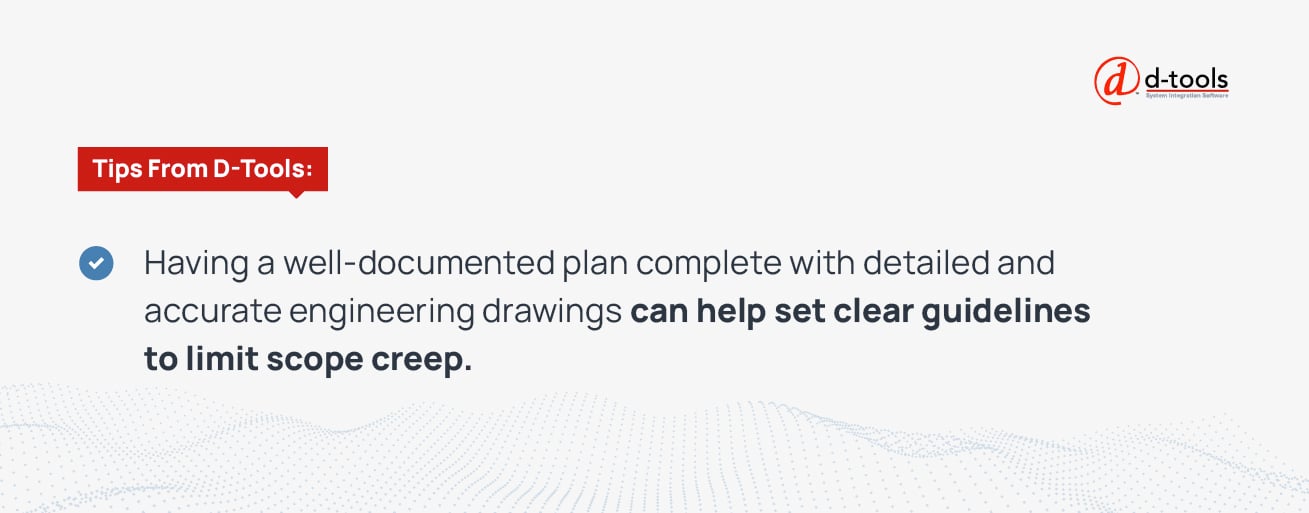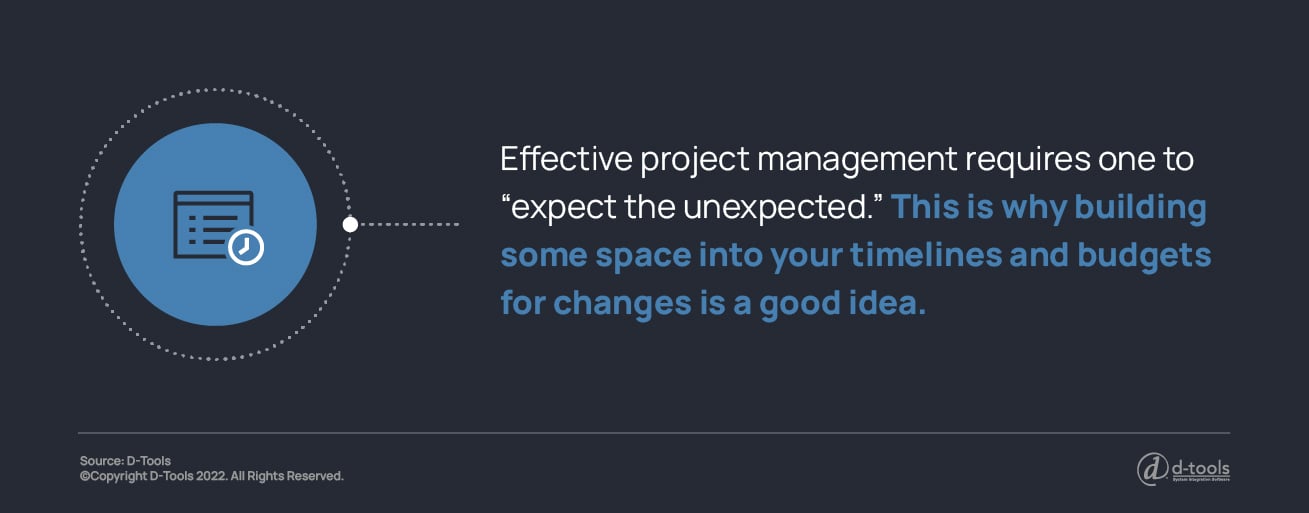Regardless of the industry, “scope creep” is a term no business wants to hear. A common challenge that exists across all fields, scope creep can cause delays, costly overages, and lead to project failure.
In this article, we’ll define scope creep while providing some common examples along with tips on how to prevent scope creep from happening in project management in the first place.
What Is Scope Creep in Project Management?
A scope is the amount of work forecasted to complete a project from beginning to end. Scope creep occurs when the amount of work changes and control procedures, like change orders, are either ineffective or absent from the project management process.
In other words, if you’re managing a project and the customer decides to expand a previously agreed upon package of goods and services along the way, you might sign an addendum to the original contract — and that’s a good thing! On the other hand, if you start a project and hit snags that your team has to handle before tackling the work you agreed upon in the original contract, that’s scope creep. Long story short: scope creep in project management is unexpected and undesirable.
Related Read - AV Project Management: What It Is & How to Do It Effectively
What Causes Scope Creep?
Scope creep can happen for several reasons, including miscommunication, changing customer needs, and underestimating the amount of work required for the project. Scope creep also occurs when a project is mismanaged. It’s a project manager’s job to keep things moving smoothly towards an on-time and on-budget project completion, and to take corrective action if/when challenges arise.
Why Is Scope Creep a Problem?
There are many reasons why scope creep is a problem. First off, it can cause delays. As scope increases, so does the number of tasks that need to be completed. This can lengthen a project’s timeline, resulting in missed deadlines.
Sadly, these delays also can have a snowball effect. When one project takes longer than expected, other projects often get pushed back. Even when customer-requested changes spark scope creep, blame tends to fall squarely on the shoulders of the project manager. Delays create frustration for customers, dealing with customer complaints creates frustration for you, and when fewer projects get completed on-time, the negative impact on your company’s bottom line creates frustration (and financial headache).
On the subject of finances, scope creep also causes costly overages. More resources are required when a project extends beyond the initial estimate. This can drive a project over budget, creating an even bigger financial headache.
Related Read - Project Resource Management: 4 Factors to Consider
In addition, when scope creep is an ongoing problem for an organization, employee morale suffers. If your team members feel as though they’re always having to go above and beyond to meet unexpected requests, stress and resentment towards customers and project managers can build up, hindering productivity, sparking turnover, and staining your company’s work culture.
Last but certainly not least, scope creep ultimately can lead to project failure if it’s not nipped in the proverbial bud. When the scope of a project is fuzzy, scope creep grows as customers and team members interpret the scope differently. If left unchecked, scope creep can spiral out of control and cause a project to become unmanageable. This can create frustration among team members and customers, and even result in a project being canceled.
4 Examples of Scope Creep
When scope creep occurs, it’s problematic at best and detrimental at worst. Here are four common scope creep examples to avoid:
1. The Scope Was Never Clearly Defined
If a project doesn’t start with a clear scope, scope creep is next to impossible to prevent. This can happen when customers aren’t sure what they want or need, want you to tell them what they want or need, or expect unrealistic project outcomes. It can also happen due to inaccuracies in project quotes, proposals, and the documentation of the statements and scopes of work themselves.
2. Poor Communication Between Stakeholders
While the previous example focuses on the initial stages of a project, the execution stages of a project are equally susceptible to scope creep.
When stakeholders aren’t communicating effectively during the course of a project, changes are often needed — and the longer that communication breaks down, the longer it takes for those changes to be completed satisfactorily.
3. Insufficient Planning
When a project is not properly planned, it can lead to disaster — costly overages, impractical timelines, and frustration from everyone involved. If project planning isn’t granular, it’s easy for the scope to expand with time, particularly if a specific outcome was promised without putting enough thought into the amount of work required to deliver it.

Insufficient planning also can occur during the system design phase. Having a well-documented plan complete with detailed and accurate engineering drawings can help set clear guidelines to limit scope creep.
4. Project Complexity
The more complicated a project, the more likely it is to have some degree of scope creep. In fact, for a very complex project, scope creep may have to be treated as an inevitability.
That said, you should still try to keep the scope of the project as simple and focused as you can. When this isn’t possible, you might need to break up a bigger project into a few smaller deliverables to keep the project from being too unwieldy.
Related Read - How to Manage Resources Across Multiple Projects
How to Prevent Scope Creep in Project Management
Now that we’ve shared some of the most common scope creep examples, let’s dig into how to prevent scope creep from happening.
Tip #1. Clearly Define the Scope from the Start
One of the best ways to prevent scope creep is to have a clear and concise scope statement from the outset.
The statement should include all deliverables, milestones, and timelines for the project to minimize the likelihood of scope creep. Incorporate the scope statement into the contract, and be sure to include a clear process for any changes. Which brings us to our next point…
Tip #2. Expect Change and Have a Process to Manage It
Scope creep can be prevented by proper scope management. This means not only creating a clear and concise scope statement at the beginning of the project, but also managing changes to a scope throughout the course of a project.

While it is important to have a clear scope at the outset, effective project management also requires one to “expect the unexpected.” This is why building some space into your timelines and budgets for changes is a good idea. Having a change management plan allows you to pivot as needed.
When changes are made to a scope, they should be properly reviewed, documented in writing, and formally agreed upon by all project stakeholders.
Tip #3. Make Sure Everyone Is on the Same Page
It is important to ensure everyone involved in a project understands the scope. This includes customers and team members alike. The scope should be clearly communicated from the beginning, and communication should continue throughout to keep everyone informed about the project's progress.
In addition to understanding the project scope and deliverables, customers also should understand your change control process. Knowing that changes can’t simply be made on the fly goes a long way in facilitating better communication.
Tip #4. Use the Right Tools
There are a number of tools available to assist in the prevention of scope creep — scope statement samples, change management plan templates, and project management software.
For example, D-Tools Cloud and System Integrator (SI) software products streamline project workflows while optimizing proposals, system designs, product procurement, field resource management, and more. When it comes to combating scope creep, project managers can leverage D-Tools software to create and track both internal and customer-facing change orders — because while you can’t prevent project changes, you can make sure you’re properly compensated for them.
Related Read - Which D-Tools Product Is Right for You?
To learn more about how D-Tools software can improve project management for your company, schedule a guided tour now.





